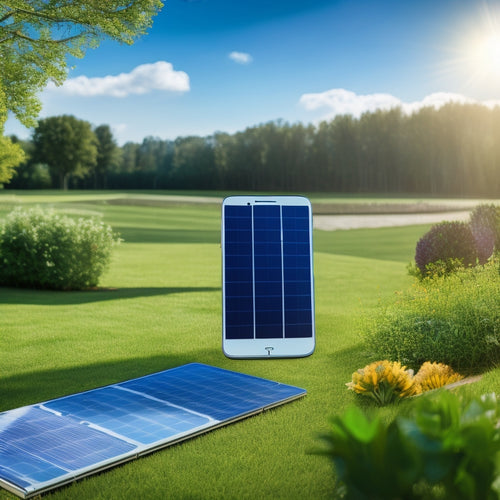
Retrofit Your Home With Geothermal: a Step-By-Step Guide
Share
You're about to commence a transformation that'll turn your home into an eco-friendly oasis. To retrofit your home with geothermal energy, start by evaluating your property's potential, including site evaluation, soil testing, and consideration of renewable energy sources. Next, choose the right system by reviewing your energy needs, examining efficiency ratings, and selecting a system that suits your property's unique conditions. With a clear plan in place, you'll be ready to tackle the installation and permitting process, integrate your new system with existing infrastructure, and start reaping the cost savings and incentives that come with going geothermal - and that's just the beginning of your sustainable living adventure.
Key Takeaways
- Assess your home's potential for geothermal installation by evaluating site conditions, soil conductivity, and energy needs.
- Choose the right geothermal system type (horizontal, vertical, pond/lake) based on your home's size, insulation, and heating/cooling requirements.
- Ensure a smooth installation and permitting process by identifying optimal component locations, obtaining necessary permits, and hiring qualified installers.
- Integrate your geothermal system with existing HVAC and plumbing systems to optimize energy efficiency and consider upgrading ductwork and piping as needed.
- Benefit from significant cost savings and incentives, including US government tax credits, by retrofitting your home with a geothermal system.
Assessing Your Home's Potential
As you consider retrofitting your home with a geothermal system, evaluating your home's potential is a vital first step. This involves conducting a thorough site evaluation to determine the feasibility of a geothermal installation.
You'll need to assess your property's size, layout, and topography to guarantee that it can accommodate the necessary infrastructure. Soil testing is also important, as it will reveal the thermal conductivity of the soil and its ability to transfer heat efficiently.
Additionally, incorporating renewable energy sources, such as solar-powered fast charging, can further reduce your carbon footprint. Furthermore, using geothermal energy can provide a sustainable alternative to fossil fuels, contributing to a cleaner environment.
This data will help you determine the most suitable system design and configuration for your property. By understanding your home's potential, you'll be able to make informed decisions about your geothermal retrofit, guaranteeing a successful and efficient installation that meets your energy needs.
Choosing the Right System
Nearly every home can benefit from a geothermal system, but selecting the right one for your property is vital.
You'll need to take into account factors like your home's size, insulation, and heating/cooling requirements. In addition, it's important to evaluate your energy needs, much like fleet owners integrating renewable energy solutions, to guarantee the system you choose can meet your demands.
There are several system types to choose from, including horizontal, vertical, and pond/lake systems. Each has its own advantages and disadvantages, so it's important to assess your property's unique conditions.
Efficiency ratings are also significant, as they directly impact your system's performance and energy savings. Look for systems with high Coefficient of Performance (COP) and Energy Efficiency Ratio (EER) ratings.
Installation and Permitting Process
Your geothermal system is only as good as its installation, so it is crucial to get this phase right. A proper installation guarantees your system operates efficiently and effectively. It begins with a site evaluation to determine the best location for your system's components. Next, you'll need to obtain necessary permits, which vary depending on your location and regulatory requirements.
| Step | Description | Responsibility |
|---|---|---|
| 1 | Conduct site evaluation | You/Installer |
| 2 | Determine regulatory requirements | You/Installer |
| 3 | Obtain necessary permits | You |
| 4 | Install geothermal system | Installer |
| 5 | Inspect and test system | Installer/Authority |
Remember to work with a qualified installer who can guide you through the process and guarantee your system meets local building codes and regulations.
Integration With Existing Systems
With the installation and permitting process complete, you can now focus on integrating your new geothermal system with existing systems in your home. This involves verifying system compatibility, particularly with your HVAC and plumbing systems.
You'll want to confirm that your geothermal system can seamlessly interact with these systems to optimize energy efficiency. Additionally, consider the importance of high-efficiency photovoltaic cells in maximizing energy generation, as well as the benefits of energy audits in identifying inefficiencies.
Check that your existing ductwork and piping are compatible with the new system, and make any necessary upgrades or modifications. Proper integration will guarantee that your geothermal system operates at peak performance, providing you with the maximum energy savings and comfort.
Cost Savings and Incentives
Many homeowners who invest in geothermal systems do so because of the significant cost savings they can provide. By utilizing the earth's natural heat, you'll reduce your reliance on fossil fuels and lower your energy bills.
In addition, moving to renewable energy sources, such as solar power for EV charging, can also contribute to a cleaner environment and enhance brand reputation. In the long term, these savings can add up, providing a substantial return on your investment.
Additionally, the US government offers tax credits to homeowners who install geothermal systems, which can help offset the initial cost. You can claim a credit of up to 26% of the total installation cost, making it even more affordable.
With geothermal, you'll enjoy long-term savings and a reduced carbon footprint, giving you the freedom to live more sustainably and independently.
Frequently Asked Questions
Can I Install a Geothermal System in a Newly Constructed Home?
Are you rebuilding from scratch? You're in luck! Since you're constructing a new home, you can seamlessly integrate a geothermal system during the building process, eliminating installation hassles and ensuring ideal system performance with careful construction considerations.
How Does Geothermal Energy Affect the Indoor Air Quality?
As you utilize geothermal energy, you're likely to notice improved indoor air quality, thanks to reduced indoor humidity and increased energy efficiency, which in turn minimizes the need for air conditioning and heating, freeing you from pollution and energy dependence.
Are Geothermal Systems Prone to Corrosion or Rusting?
You breathe a sigh of relief, knowing that geothermal systems aren't inherently prone to corrosion or rusting, thanks to durable materials and proper installation; however, you'll still need to prioritize system longevity through regular maintenance practices to guarantee peak performance.
Can I Use Geothermal Energy for Heating My Pool or Hot Tub?
You can utilize geothermal energy for efficient pool heating and hot tub heating, reducing your carbon footprint and energy bills; a desuperheater or heat exchanger can be integrated into your system to repurpose excess heat for these applications.
Will a Geothermal System Increase My Property Value?
As you invest in a geothermal system, you're not just warming your home, you're increasing its worth; in fact, a study shows that energy-efficient upgrades can enhance property value by up to 10%, making your home a hot commodity in the eyes of a property appraisal.
Related Posts
-

Why Choose Recycled Paper for Earth-Conscious Business?
By choosing recycled paper, you'll greatly reduce your business's environmental impact. You'll lower your carbon foot...
-

Why Choose Cool Roofs in Scorching Climates?
You opt for cool roofs in scorching climates because they enable you to reclaim control over your energy consumption ...
-

7 Best Solar Panel Upkeep Apps for Homeowners
You can optimize your solar panel's energy output and efficiency by up to 20% with regular maintenance, which is wher...


